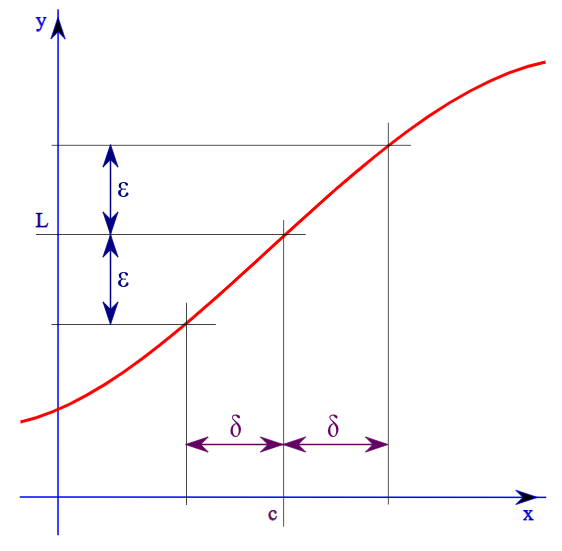
How do you use the epsilon delta definition to find the limit of \[\left( {\dfrac{{{x^2} + x - 6}}{{x - 2}}} \right)\]as \[x\] approaches \[2\]\[?\]
Answer
508.8k+ views
Hint: Here we have to check that the given function is defined or not at \[x = 2\]. If it is defined, then by the definition epsilon delta finds the relationship between epsilon and delta to prove the limit of the given function as \[x\]approaches to \[2\] it exists and is unique.
Complete step by step solution:
The epsilon-delta definition of limits says that the limit of \[f(x)\]at \[x = c\]is \[L\] if for any \[\varepsilon > 0\] there exists a \[\delta > 0\] such that if the distance of \[x\] from \[c\] is less than \[\delta \], then the distance of f(x) from \[L\] is less than \[\varepsilon \].
Graphical representation of the epsilon-delta definition:

Let the given function say \[f(x) = \left( {\dfrac{{{x^2} + x - 6}}{{x - 2}}} \right)\] and \[L\] be the limit of the given function.
At \[x = 2\], the given function approaches infinity. So, rewriting the given above function, we get \[f(x) = x + 3\]. Hence at \[x = 2\],\[f(2) = 5\].
\[ \Rightarrow \] \[\mathop {\lim }\limits_{x \to 2} \left( {\dfrac{{{x^2} + x - 6}}{{x - 2}}} \right) = 5\]
We prove by the epsilon delta definition, for any \[\varepsilon > 0\] there exists a \[\delta > 0\] such that
If \[\left| {x - 2} \right| < \delta \] \[ \Rightarrow \] \[\left| {f(x) - L} \right| < \varepsilon \]
\[ \Rightarrow \left| {x + 3 - 5} \right| < \varepsilon \]
On simplification,
\[ \Rightarrow \left| {x + 2} \right| < \varepsilon \]
\[ \Rightarrow \left| {x + 2} \right| < \delta \]
From the above two equations, we can say
\[ \delta = \varepsilon \]
Hence the limit of \[\left( {\dfrac{{{x^2} + x - 6}}{{x - 2}}} \right)\]as \[x\] approaches \[2\] is \[5\].
Note:
Note that If the limit of the given function at the given point exists then the limit is unique and finite. A function is continuous if you can draw its graph without lifting the pencil. Every differentiable function is continuous but converse is not true.
Complete step by step solution:
The epsilon-delta definition of limits says that the limit of \[f(x)\]at \[x = c\]is \[L\] if for any \[\varepsilon > 0\] there exists a \[\delta > 0\] such that if the distance of \[x\] from \[c\] is less than \[\delta \], then the distance of f(x) from \[L\] is less than \[\varepsilon \].
Graphical representation of the epsilon-delta definition:

Let the given function say \[f(x) = \left( {\dfrac{{{x^2} + x - 6}}{{x - 2}}} \right)\] and \[L\] be the limit of the given function.
At \[x = 2\], the given function approaches infinity. So, rewriting the given above function, we get \[f(x) = x + 3\]. Hence at \[x = 2\],\[f(2) = 5\].
\[ \Rightarrow \] \[\mathop {\lim }\limits_{x \to 2} \left( {\dfrac{{{x^2} + x - 6}}{{x - 2}}} \right) = 5\]
We prove by the epsilon delta definition, for any \[\varepsilon > 0\] there exists a \[\delta > 0\] such that
If \[\left| {x - 2} \right| < \delta \] \[ \Rightarrow \] \[\left| {f(x) - L} \right| < \varepsilon \]
\[ \Rightarrow \left| {x + 3 - 5} \right| < \varepsilon \]
On simplification,
\[ \Rightarrow \left| {x + 2} \right| < \varepsilon \]
\[ \Rightarrow \left| {x + 2} \right| < \delta \]
From the above two equations, we can say
\[ \delta = \varepsilon \]
Hence the limit of \[\left( {\dfrac{{{x^2} + x - 6}}{{x - 2}}} \right)\]as \[x\] approaches \[2\] is \[5\].
Note:
Note that If the limit of the given function at the given point exists then the limit is unique and finite. A function is continuous if you can draw its graph without lifting the pencil. Every differentiable function is continuous but converse is not true.
Recently Updated Pages
Master Class 12 Business Studies: Engaging Questions & Answers for Success

Master Class 12 Economics: Engaging Questions & Answers for Success

Master Class 12 English: Engaging Questions & Answers for Success

Master Class 12 Maths: Engaging Questions & Answers for Success

Master Class 12 Social Science: Engaging Questions & Answers for Success

Master Class 12 Chemistry: Engaging Questions & Answers for Success

Trending doubts
What is meant by exothermic and endothermic reactions class 11 chemistry CBSE

Which animal has three hearts class 11 biology CBSE

10 examples of friction in our daily life

One Metric ton is equal to kg A 10000 B 1000 C 100 class 11 physics CBSE

1 Quintal is equal to a 110 kg b 10 kg c 100kg d 1000 class 11 physics CBSE

Difference Between Prokaryotic Cells and Eukaryotic Cells




